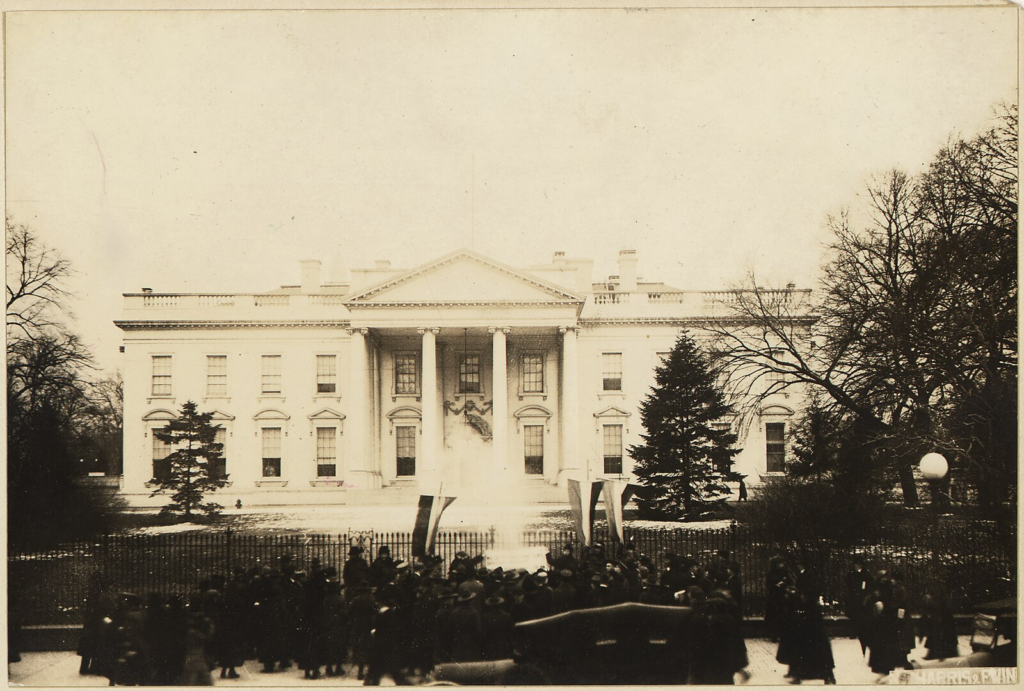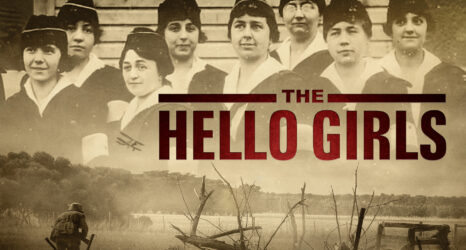
From 1917 to 1919, police arrested over 200 women, ages 19 to 73, from 26 states, for the trumped-up charge of “obstructing traffic.” Known as the Silent Sentinels, these stalwarts staged ongoing, wordless, peaceful pickets on the White House sidewalk in all kinds of weather for the right to vote—as President Woodrow Wilson, cloistered inside, dodged and dawdled.
Donned in purple, gold and white sashes, the demonstrators hoisted tall banners posing questions like “how long must women wait for liberty?” Against the background of U.S. involvement in World War I, they pointed out Wilson’s hypocrisy in fighting for democracy abroad while denying it at home.
No group had ever picketed the White House before, according to Jennifer Krafchik, Acting Director, Belmont-Paul Women’s Equality National Monument. Many viewed women picketing during wartime as unpatriotic, so the police arrested 70 women on November 14, 1917. Given the choice of a $25 fine or incarceration, they chose jail. “Not a dollar of your fine shall we pay,” protested National Women’s Party co-founder Lucy Burns. “To pay a fine would be an admission of guilt. We are innocent.”
Officers then hauled the women to the Occoquan Workhouse, 25 miles south of Washington in Lorton, Virginia, where jailers fed the “law-breakers” maggot-laden food and stripped, dragged and clubbed them before they housed them in rat-infested cells alongside drunks and thieves. Guards manacled Burns by her hands to the overhead cell bars, forcing her to stand all night. When some of the suffragists went on a hunger strike, jailers force fed them raw eggs and milk through a tube inserted into their nasal passages. The women called this the “Night of Terror.”
Public exposure of the male guards’ abusive treatment galvanized public support for suffrage and created sticky political discomfort for Wilson, who still stonewalled. In 1918, he finally proposed that Congress pass the Susan B. Anthony amendment guaranteeing women suffrage as “a necessary war measure.” (To pressure Wilson to actively advocate for the amendment, the women built “watch fires” in Lafayette Park and burned his speeches.)
Five years earlier, 8,000 “uppity” women had upstaged President-elect Wilson’s inauguration when they marched down Pennsylvania Avenue carrying banners proclaiming “Liberty, Equality, Fraternity.” Their leader, attorney Inez Milholland, wearing white robes astride a magnificent white horse, invoked Joan of Arc. People on the sidelines, mostly men, hurled jeers and nasty insults, deriding these dogged women as “unwomanly,” “unsexed” and “pathological.” About 100 marchers were hospitalized after suffering injuries from the hostile onlookers. When Wilson disembarked at Union Station, disappointed at the size of his own greeting party, he asked where everyone was. “On the avenue,” came the answer, “watching the suffragists’ parade.”
If all of this sounds familiar, it’s because it is. Suffragists were pioneer #MeToo-ers: gutsy, fair-minded foremothers who stood up to abusive men, took to the streets, spoke out and righted wrongs. Their parade was an earlier Women’s March—protesting a president who didn’t value women’s rights and wouldn’t listen to women’s voices. But many of those using the viral hashtag to fight harassment or donning pussyhats to storm the streets and advance feminism may not be familiar with their own history.
That’s why the Turning Point Suffragist Memorial Association is building a national monument to tell this little-known chapter of American history and to honor the five million women who fought from 1848 to 1920 for the right to vote. Visitors will enter through replica White House gates, backdrop of the suffragists’ pickets, and see a Jail Door/Shackled Hands Suffragist sculpture. Nineteen education stations will recount the history of the movement, including court cases that denied women’s rights, nine unsuccessful suffrage campaigns, the Night of Terror in the workhouse and state ratification campaigns.
Organizers hope to complete construction by 2020, the centennial of the 19th amendment’s ratification—and, of course, the year of our next presidential election. The memorial will join other historic sites as part of a Constitution Trail within a day’s drive of Mount Vernon, home George Washington (and Martha); Gunston Hall, home of the Virginia Declaration of Rights author George Mason (and Sarah); Montpelier, home of James Madison, an author of the Constitution (and Dolley); and several Civil War battlefields where the concept of “united states” was at issue.
“The suffragists engineered the greatest expansion of democracy on a single day the world had ever seen,” wrote Eleanor Clift, columnist and author of Founding Sisters and the Nineteenth Amendment, “and yet… the leaders built no monuments to themselves, and too many of their names have been lost to history.”
The suffragists’ 1917 jailing and their unfailing fortitude were a turning point in the ultimately successful 72-year struggle for the ballot. Decades of civil disobedience led to ratification of the 19th amendment in 1920, instantly giving 22 million women the right to vote. It is long past time to make these women’s stories of courage and defiance more well-known, and to honor their contributions to our now-more-perfect union.
“Failure is impossible,” suffrage crusader Susan B. Anthony famously said. That theme inspired a cadre of dedicated suffragists—and today inspires the monument’s champions.





